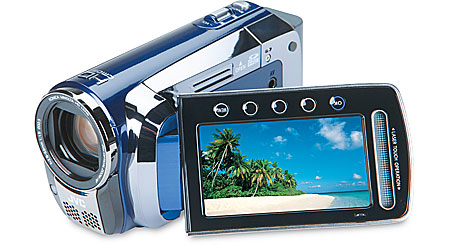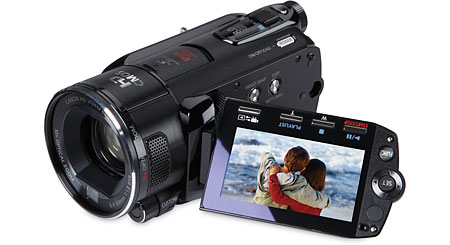If you’ve heard about hard drive and flash memory, or “solid state drive,” camcorders, but want more info, you’re in the right place. In this article, we’ll cover all kinds of details, from storage type, to editing, to watching video on your TV. You can also get the scoop on other digital camcorders in this article on finding the right camcorder.
Today’s hard drive camcorders are packed with powerful features and ample storage capacity. (Sony HDR-XR520V shown above)
Hard drive and flash memory camcorders
Hard drive and flash memory camcorders store video files to a small built-in hard drive or microchip, similar to the way we store files in our computers or in some MP3 players. When it comes to video quality, they tend to perform on par with today’s DVD camcorders, although some high-definition models are ranked even higher.
High memory capacity and small, portable design
Hard drive camcorders come with varying amounts of memory, from 30-gigabytes to 120-gigabytes or even more. The potentially enormous storage capacity of these cams is one reason for their increasing popularity. For example, a camcorder with a built-in 30-gigabyte hard drive can generally store about 7 hours of footage, at the cam’s top recording quality setting. Switch it to “Standard,” and you’ll get almost 14 hours. By comparison, camcorder formats like Mini DV, which uses tapes, or DVD, which uses 8cm DVD discs, can only store 30-60 minutes on each piece of media. Another plus of a hard drive camcorder is that you don’t have to worry about rewinding to review a scene, and then accidentally taping over it when you next hit “Record,” since the camcorder automatically saves video footage to free space on the hard drive.
Flash memory camcorders currently offer memory varying from 8GB, which gives you about 2 to 5 hours of standard footage, to 32GB, which can hold about 8 to 20 hours of standard footage. The advantage of flash memory is that it doesn’t have any moving parts, so it’s considered more durable than hard drive memory. Flash memory camcorders generally record and access media faster than hard drive camcorders. And given the tiny size of flash memory, flash memory camcorders can be smaller and lighter too.
Both hard drive and flash memory camcorders make great traveling companions for short trips. Along with their small size, their relatively large storage capacity means there’s no need to lug tapes, discs, or a laptop around with you. There’s no doubt that hard drive camcorders represent a gain in versatility and portability, but you do tend to lose a little in affordability. Because of the advanced technology hard drive camcorders contain, they tend to cost more than beginner-level Mini DV and DVD camcorders. And you’ll pay a little more than twice as much per gigabyte of flash memory than you would for hard drive memory.
Flexible recording with multi-format camcorders
So what happens if you run out of room? While that’s not a likely scenario for many folks, a lot of hard drive and flash memory cams also have memory card slots to allow a few gigabytes of extra room for video and photos. Memory cards, a type of removable flash memory, are especially handy when you want to add extra memory to your camcorder. When your cam’s internal memory fills up, you don’t have to pick which video segments you’ll discard — you can just pop in a memory card. The most common types of memory cards found in camcorders are SD (Secure Digital®) cards or Memory Sticks®.
A camcorder with a built-in memory card slot might also be a good choice if you’re interested in sharing video clips online. These cams make it easy to record video clips and images to the memory card and then pop it into a memory card reader or card slot on your printer and upload clips to a video-sharing site, like YouTube, or e-mail to friends and family.
Some flash memory cams go one step further and offer three recording options: flash memory, a memory card slot, and a DVD drive. These tri-format cams often offer in-camera dubbing, which lets you select scenes stored on your memory card or flash drive and copy them to DVD discs for easy video sharing. So if you’re concerned about recording space on a longer trip, you can bring along an extra memory card or DVD just in case, or buy one at your destination.

Camcorders with built-in memory card slots give you even greater flexibility. (JVC GZ-HM200 pictured above)
Watching your footage
So how do you view your saved video files? Audio/video outputs let you connect your cam to your TV for direct playback of your footage, while a USB output (typically high-speed) lets you transfer the video files onto your computer for editing. Since detailed video files are large, you’ll want to make sure you have ample memory space to store these files. We actually recommend using an external hard drive to keep a backup copy of your footage, as it saves space on your PC, and ensures you’ll have a copy of precious footage if your camcorder gets damaged. If your computer has a DVD burner, you can use compatible digital video editing software (sometimes included with the camcorder) to create a DVD of your favorite highlights.
You can also use a separate DVD recorder to make copies of your footage. Many are specifically designed for use with hard drive camcorders. And these recorders don’t require you to use a PC — simply connect your hard drive camcorder and record your movies on regular, full-sized DVDs that you can play with most newer DVD players. It’s worth noting that high-definition hard drive camcorders require a special kind of DVD recorder that’s capable of burning their detailed footage to DVD. Typically, you can watch these discs using the DVD recorder or a compatible Blu-ray Disc™ player.
High-definition hard drive and flash memory camcorders
High-definition recording capability is something you’ll find on an increasing number of camcorder models. HD camcorders capture widescreen video in 1080i resolution, which is the same resolution used for most high-def programs on TV today. They’re a great advantage to folks who want the best picture quality currently available, or who have a widescreen HDTV and want home movies to match. (Many of these camcorders also offer a standard-definition mode with a more traditional squarish 4:3 aspect ratio, so you’ll be able to choose whichever resolution best suits your needs.)

High-definition hard drive and flash memory camcorders generally use larger lenses and more sophisticated imaging processors, for the clearest, most accurate video possible. (Canon HF S10 shown above)
Because high-def footage requires so much more memory space, the ample storage ability we discussed before in hard drive and flash memory camcorders will be noticeably curtailed — for instance, a 30-gigabyte drive that can store over 7 hours of standard-definition video can only store about 4 hours of high-def AVCHD video. If you’re opting for a high-def camcorder, you’ll definitely what to look for one with a memory card slot so you can record photos and other small video clips to the memory card, and reserve the precious hard drive or internal flash memory space for your high-def footage.
With high-def hard drive and flash memory camcorders, transferring files to a PC still takes place via a USB connection. But if you plan to do a lot of editing, make sure that you have the processing power you need as well as software that can handle high-definition video (not every camcorder comes with full editing software). For example, many high-def hard drive and flash memroy camcorders record in the new AVCHD file format (high-def DVD camcorders use this format as well). Yet only some of the most recent versions of editing programs can fully handle AVCHD, so if you plan to edit your HD footage and record it to a disc, make sure you get software that is AVCHD-friendly. You can see our article on watching, sharing, and editing your home movies for more tips.
If you have a PC with a Blu-ray Disc™ drive and a separate Blu-ray player, you may be able to store your videos in full resolution on high-definition discs and play them back that way. Some of the newer DVD recorders for camcorders will also let you save HD footage directly to DVDs that you can play back using a compatible Blu-ray player, or using the DVD recorder itself. Most owners of a new HD camcorder will be using the cam’s audio/video outputs to get their recorded videos to their TV. To let you take advantage of your high-def video recordings, HD camcorders offer either component video or mini- or full-sized HDMI outputs. (They also offer other analog outputs for older TVs.) With a high-quality connection to your TV, your home movies will look crisp and detailed — almost professional.
In short, hard drive camcorders and flash memory make sense if you:
- want the ample recording time of a hard drive
or
- want the extreme lightness and flexibility of flash memory
and
- want a wide range of features
- don’t need precise, frame-by-frame editing
- plan on doing a lot of traveling and don’t want to carry along tapes or discs
- wish to connect to your PC by way of high-speed USB
- want high-def recording

by Tara Wisnewski, Crutchfield.com. All rights reserved. (reprinted with permission, originally posted April 30, 2009)






























